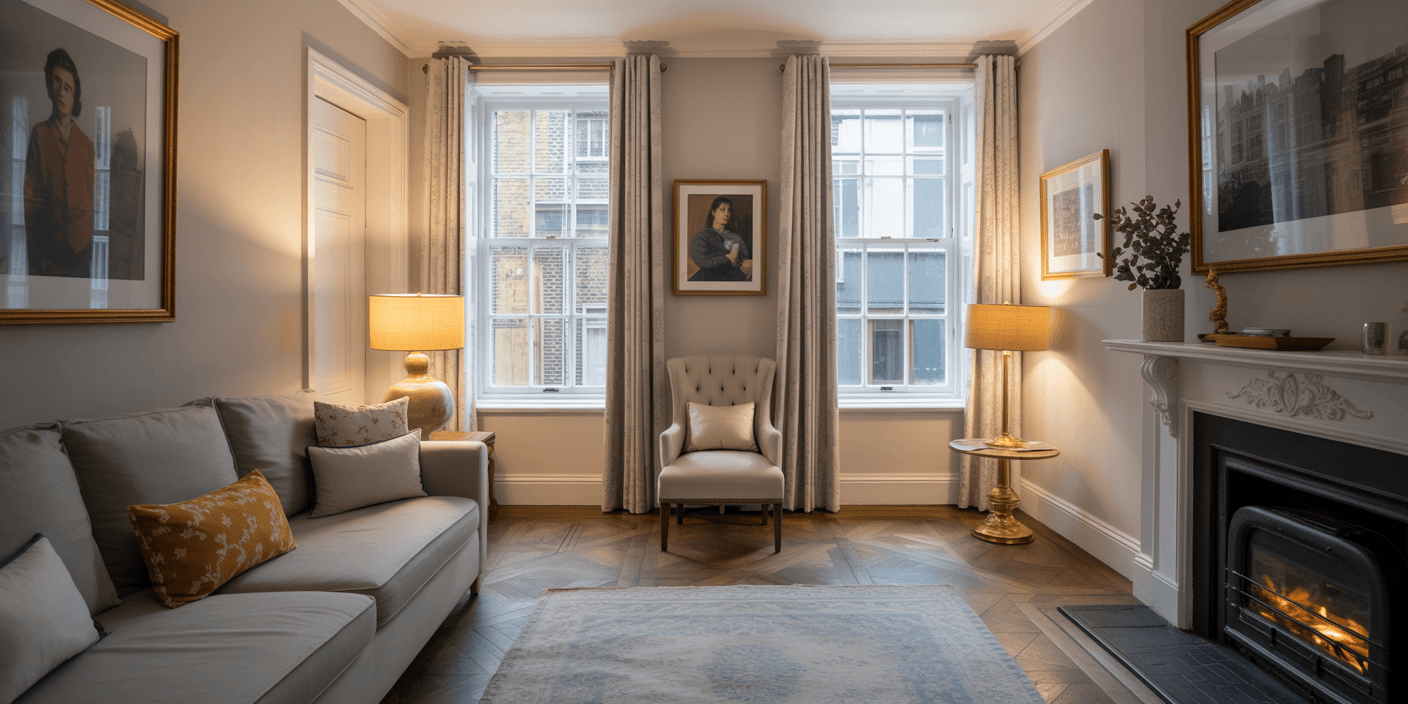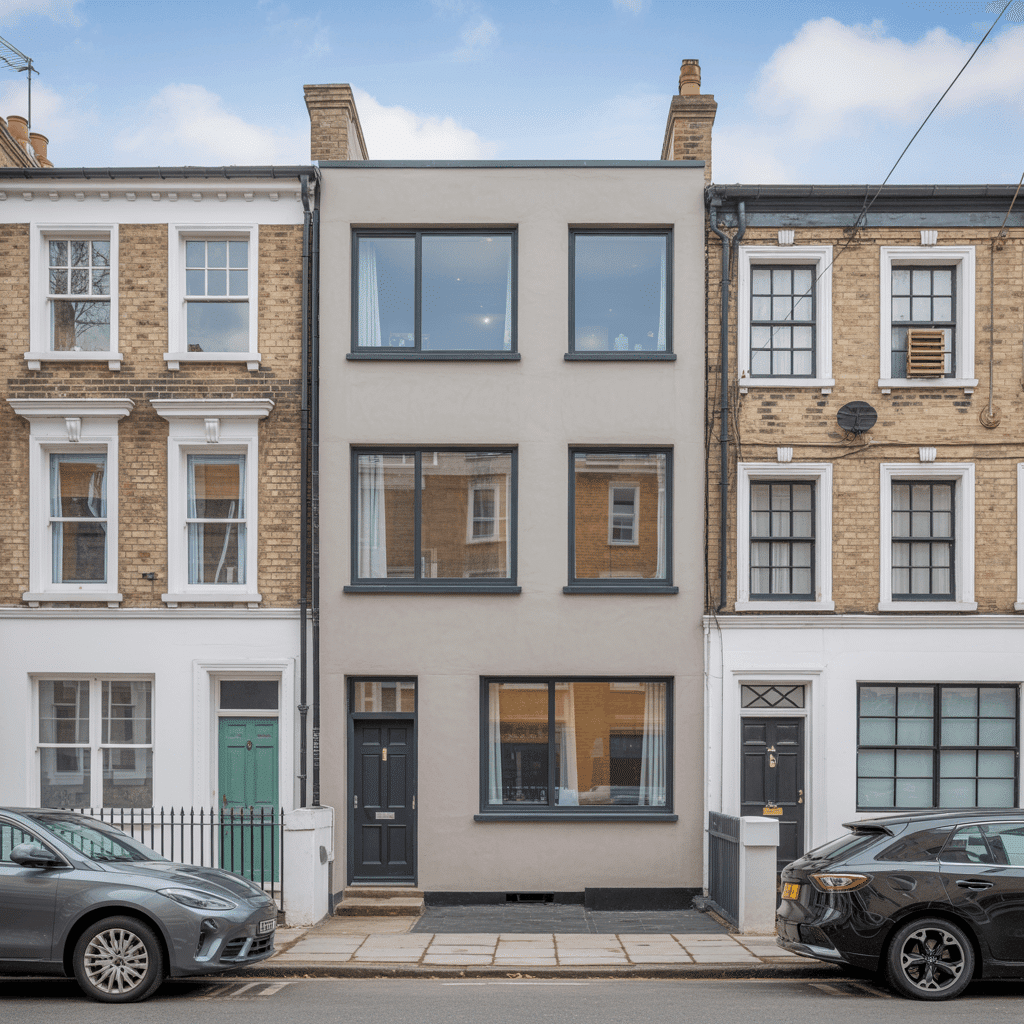The Cold Truth About Period Properties
If your windows are original, your energy bills are almost certainly inflated.
In the elegant silence of a Georgian terrace or a Victorian townhouse, it’s easy to forget where the heat escapes. But the culprit is rarely the roof — it’s the glazing.
Original sash windows, for all their visual charm, are among the least efficient elements of a period home. They allow heat to dissipate freely. Cold air filters in through slender gaps. The faint rattle of timber under pressure is a subtle, persistent reminder: this is architecture of another era — and its energy performance reflects that.
Yet too often, homeowners accept this inefficiency as a necessary trade-off for heritage. They believe that improving insulation must come at the cost of character. That high-performance glazing means heavy frames, awkward proportions, or an architectural compromise.
That assumption is no longer valid.
Thanks to advances in passive-grade glazing and precision joinery, it is now entirely possible to preserve the integrity of a sash window’s appearance while transforming its thermal performance. Triple-glazed sash systems can replicate original sightlines — even in listed buildings — and quietly deliver U-values that rival modern construction.
If your windows whistle in the wind, if the heating fights a losing battle in winter, or if condensation haunts the glass each morning, the fault isn’t your home.
It’s your glazing.
And the answer, today, is entirely within reach.
What Is Low‑E Triple Glazing — And Why It Changes Everything
It looks like glass. It behaves like intelligence.
Most homeowners think of glass as a passive material — transparent, silent, static. In reality, modern glazing is one of the most active technologies in your home. It doesn’t just separate you from the weather. It regulates how your home feels, performs, and consumes energy.
That’s where Low‑E triple glazing comes in — the quiet revolution hidden in the frame.
Low‑E stands for Low Emissivity — a microscopically thin, invisible coating applied to the inner face of the glass. It works like a mirror for heat: reflecting warmth back into the room while letting natural light flood through. The result is radiant comfort, not wasted heat.
Now, multiply that efficiency across three panes of glass. Between them sit argon‑filled chambers and warm edge spacers, designed to interrupt the cold bridge that drains energy in older units. The outcome: a U‑value as low as 0.8 W/m²K — the kind of number usually reserved for Scandinavian Passive Houses, not Victorian terraces in Islington.
But numbers only tell part of the story.
Because Low‑E triple glazing doesn’t look different. There are no bulky frames, no tinted reflections, no giveaway coatings. It’s as discreet as it is effective.
Every surface, every spacer, every air gap is designed to do one thing — make your home warmer, quieter, and cheaper to run without changing a single architectural line.
This is what makes it extraordinary: the intelligence is invisible.
No one sees it. Everyone feels it.
That’s the promise — and the quiet confidence — behind every Sash Windows London system: heritage on the outside, passive performance within.
The Myth: “You Can’t Modernise a Period Property”

They told you it couldn’t be done. They were only half right.
If you’ve ever tried to renovate a period home, you’ve heard the warnings:
“Planning won’t approve it.”
“You’ll ruin the look.”
“Triple glazing doesn’t work with sash windows.”
It’s the same tired myth, whispered by estate agents, repeated by well-meaning builders, and muttered by neighbours who haven’t looked beyond the big-box showroom. And for a time, it was true.
But it isn’t anymore.
Today, heritage glazing doesn’t just exist — it excels. With the right engineering, even triple-glazed sash windows can pass scrutiny from the most fastidious planning officer, blend seamlessly with Georgian brickwork, and satisfy modern building regulations — all at once.
Sash Windows London exists in that exact intersection:
- Approved in conservation areas across London and the Home Counties
- Installed in Grade II listed townhouses, mansion block conversions, and green belt renovations
- Trusted by architects to submit and win planning applications
We’re not guessing what will pass. We’ve already installed it.
This isn’t a compromise. It’s precision.
Each window is designed in CAD-matched profiles, with joinery that replicates 19th-century sightlines, yet houses 21st-century insulation, security, and glazing tech within.
The result?
- The building keeps its heritage.
- The homeowner keeps their heat.
- And the planning officer?
Approves it.
Because when authenticity and performance meet, regulations don’t resist — they endorse.
How the Windows Work — Without Anyone Knowing They Did
You don’t hear them. You don’t see them. You only feel the difference.
To the eye, nothing has changed. The meeting rail sits perfectly aligned. The frame depth holds true to the original. The horn detail, sash proportions, and glass division all honour the past with near-forensic precision.
But behind the joinery?
A quiet technological symphony.
This is where Sash Windows London excels — not by shouting innovation, but by concealing it so flawlessly that even a heritage officer would struggle to spot the upgrade.
Inside each unit, Low-E triple glazing is suspended in a timber frame engineered to fractions of a millimetre. It’s housed within profiles matched to historical originals, adapted internally to accommodate warm-edge spacers, gas-filled chambers, and acoustic dampening layers — without bulking the sash or sacrificing reveal depth.
And what about the weight?
Triple glazing is heavier — significantly so — but the balance is restored with high-precision spiral balances, calibrated to lift with ease, stop on command, and glide with silent authority. No ropes, no weights, no clatter — just clean movement, like opening the lid of a well-made piano.
The draught-proofing system is integrated, not added. No afterthought brush strips or external seals. Every component is recessed, colour-matched, and tested for Part L and Part Q performance without visual compromise.
Even the ironmongery — every lock, lift, fastener — is chosen not just to complement the aesthetic, but to satisfy PAS 24 security requirements.
The result?
A window that doesn’t look like it’s changed.
Only your experience of the room does.
The room warms quicker. The silence settles faster. The street fades. The windows vanish into the architecture, and for the first time, your home feels finished.
This is more than restoration.
This is discreet, deliberate modernity — camouflaged in craftsmanship.
Heat Retention, Noise Reduction, and Passive Comfort
The upgrade you never see. The comfort you never want to live without.
Warmth isn’t just a number on the thermostat. It’s the absence of cold near your feet. It’s a silent room on a stormy night. It’s a home that holds the temperature — and holds it with grace.
That’s the promise of triple-glazed, Low‑E sash windows.
They don’t just outperform expectations.
They outfeel them.
Let’s start with heat.
Old sash windows are notorious for heat loss — not just through the gaps, but through the glass itself. Even with draught seals, traditional glazing allows radiant heat to escape. But with Low-E coatings and triple-glazed chambers, that energy is reflected back into the room. It stays where it’s supposed to: with you.
For most homeowners, this means:
- Fewer cold zones near windows
- A faster rise in ambient warmth
- Significantly reduced central heating use
And when paired with proper insulation and airtightness, these windows achieve passive house levels of performance — all without touching the soul of the building.
Now, let’s talk about noise.
If you live in London — or any dense urban area — you already know: sound is a form of stress. From passing buses to midnight mopeds, the city doesn’t sleep. But you can.
With acoustic dampening layers embedded between the panes, these sash windows cut external noise by up to 43dB — enough to take a busy street and reduce it to a whisper. Enough to make conversation easier, sleep deeper, and your mornings feel more like the countryside than Camden.
It’s hard to explain what that kind of quiet feels like.
Until you open the window again.
And suddenly remember what you’ve been missing.
from Planning to Installation — The Experience That Rewrites Expectations

No chaos. No compromise. Just a team that already knows what your home needs.
Replacing sash windows in a period property is not like buying a boiler or repainting a room. It’s a multi-layered operation — one that touches planning law, thermal performance, architectural history, craftsmanship, structural balance, and often, local authority politics.
That’s why the experience matters as much as the product.
With Sash Windows London, you’re not “ordering windows.”
You’re commissioning an outcome.
It starts with understanding.
Your first conversation isn’t with a salesperson. It’s with a sash window specialist — someone trained not just in specs, but in planning restrictions, heritage styles, and compliance. They’ll ask how your home feels in winter, whether you’ve dealt with planning before, what era the windows were made in, and what you value most: warmth, silence, looks, or longevity.
From there, you’re offered a tailored specification review, complete with:
- CAD drawings matched to your property’s existing frames
- Planning officer‑friendly detailing
- Thermal performance simulations
- Ironmongery and timber options that pass both scrutiny and time
Manufacture is done in‑house.
That means joiners who’ve seen your drawings, who know the streets you’re on, and who craft each unit for a specific reveal, not a generic opening. Nothing is mass-produced. Nothing outsourced. Every curve, groove, and counterbalance is measured — not guessed.
Installation is conducted with reverence.
There’s no mess, no subcontractors, no surprises. Just qualified installers who arrive on time, protect the space like it’s listed (because it might be), and leave behind nothing but silence and symmetry.
It ends when you walk into the room and say:
“It looks exactly the same — but it feels completely different.”
Because that’s the whole point.
What Clients Say — Without Being Asked To
They don’t talk about the windows. They talk about how the house feels.
When people write to us after their installation — and they often do — they rarely mention the glazing spec. They don’t reference U-values or gaskets or warm-edge spacers.
They talk about silence.
They talk about warmth.
They talk about the strange feeling of being at home in a way they didn’t expect.
One client in Kensington wrote:
“It’s not just the temperature. The house feels calmer. The noise is gone. Even my partner stopped asking if the radiators were on. It’s like the windows closed a loop in the house.”
A young couple in Dulwich sent us photos a week after moving in:
“The windows are perfect — but what impressed us most was how little disruption there was. Your team worked like museum conservators, not contractors.”
A retired architect in Hampstead Heath — whose brief included conservation consent and Passive House thresholds — told us:
“I’ve been recommending you to clients for years. Finally had a chance to use you myself. I expected excellence. I got humility, mastery and results.”
You can’t buy this kind of feedback.
You can only earn it through precision, restraint, and respect for the home as more than just a structure.
No gimmicks.
No inflated guarantees.
Just work that speaks through its silence.
And the more you listen to our clients, the clearer one thing becomes:
They don’t say much about the windows.
That’s how you know they’re perfect.
Book a Consultation — Experience the Warmth of Precision
We don’t sell windows. We specify legacy comfort — one frame at a time.
If this article spoke to you, it’s likely because your home matters. Not just how it looks, but how it lives.
You don’t want to compromise.
You want heritage without draughts. Elegance without echo.
You want the sash window your home was always meant to have — if it had been built for this century.
That’s where we begin.
Our consultations are quiet, detailed, and led by specialists — not salespeople. We start by understanding your home’s architecture, layout, energy usage, and historical parameters. We assess glazing options, compliance routes, and planning variables.
From there, we create your legacy specification:
- Thermal performance modelling for your exact rooms
- Sightline‑matched CAD visuals for planning submissions
- Timber, finish, ironmongery, and acoustic tuning — all shaped to your intent
This isn’t a quote.
It’s a design dossier for the future you want — delivered in a way that respects your home’s past.
You don’t have to commit today. But you should know:
The best time to preserve warmth, silence and value is always before you lose more of them.
Request Your Legacy Window Specification
→ Book a private consultation with a Sash Windows London specialist.
→ Get planning‑friendly drawings, thermal insight, and design certainty.
→ Bring your home into the future — invisibly.
Your house has history. Let’s futureproof it — without rewriting it.







